Palin’s Beehive and Other Political Fashion Statements
by Tove Hermanson on Oct 14, 2008 • 3:42 pm 1 Comment“There are three things woman politicians get more ink in the press over than males. One is hairdo, two is hemline and the third is their husband, as society tends to be very concerned about these things with women politicians, and we’ve seen it with Sarah Palin,” said Nichola D. Gutgold, associate professor of communication arts and sciences at Penn State Lehigh Valley in Fogelsville.
I just read a silly tidbit in New York Magazine, hoisted from a gossip blurb in the New York Daily News: a former co-contestant of the 1984 Miss Alaska beauty pageant claims that Sarah Palin kept her hair cemented in it’s do with an entire can of Aqua Net hairspray. “An Alaskan gale wouldn’t have moved a hair on her head,” the informant Pamela Massey stated. In looking for a picture to attach to this post using the Google search term “Sarah Palin beehive,” I discovered a host of sites that have discussed this seemingly frivolous topic at length, including the New York Times!
But it this discussion actually superficial? Though I certainly see the silliness in devoting news space to something as seemingly inconsequential as a politician’s hairstyle, a woman’s hair is still one of the most fetishized aspects of her. Though it often goes unspoken, female politicians have to walk a fine line of presenting themselves as attractive — because we love a leader who’s easy on the eyes — but not sexy — because a woman’s sexuality is still feared, probably because of the implied power she has upon those attracted to her. And people have strong opinions about Palin’s hair: some think it’s sleek and modern while others see it as outdated and/or frumpy. But all these adjectives could be — and I believe actually are — about Sarah herself. After all, she chose the hairdo and as she’s been in both pageants and politics, I’m quite sure she gave considerable thought to her tresses. Likewise, I believe it was a deliberate decision to have her hair in a more casual ponytail beehive variation that allies her with all those ponytailed soccer moms she’s trying to win over:
And here is Palin pre V.P. nominee (I love this!):
In the Times article her hairdresser (at the aptly named Beehive Salon) reveals that Sarah wanted to look taller on camera, which was a big (haha) issue for shrimpy 5′ 11″ G. W. Bush when running against John Kerry’s 6′ 3″. (During debates, you could see by the podium that the camera was more zoomed in on Bush so in split screen he filled as much of the frame as Kerry did, because it’s well documented that the masses tend to vote for the taller guy. It seems the camera trick worked in this instance.) Curiously, Palin’s beehive has since become a popular wig style for orthodox Jewish women. The religious but apolitical SavySheitels.com sells the V.P. hopeful’s namesake hairpiece in addition to the less currently popular Hillary Clinton wig(!).
“For me, the heels are on, the gloves are off,” Palin declared at an October rally in an attempt to rescue McCain’s precarious campaign. I thought it interesting that she used this sly metaphor to refer to her femininity and political viciousness, especially after she has been criticized (or at least commented upon) for sporting a pair of Naughty Monkey hot red peep-toe pumps the day she was introduced as McCain’s running mate. The Naughty Monkey brand is generally marketed to “women in their early to mid-20s who go clubbing,” like frequent patron Paris Hilton. Criticism notwithstanding, sales of Naughty Monkey shoes have increased by 50% on Amazon since Palin wore them.
This all seems reminiscent of the buzz around Hillary’s brightly colored campaign suits, which became such a joke that Hillary eventually poked fun at herself over it. But what was she trying to convey with these vivid pant suits? First, it should be noted that women were not allowed to wear pants on the Senate floor until the early 1990s, and Hillary clearly has been embracing that recent sexist sartorial victory ever since. Second, a well tailored suit is a symbol of — dare I specify “masculine” — power, strength, and control, but the bright colors made Hillary’s distinctively feminine. They wouldn’t have been everyone’s hues of choice, but it was a bold stylistic decision and having a consistent, identifiable style is a subtle cue that the person under the clothes is consistent him/herself. Whether this cue is accurate or not is debatable, but the point remains that the wardrobe is a visual extension of what a politician’s speeches should be verbalizing. Lastly, being as easily visible as an emergency flare cannot hurt when you’re attempting to attract attention in a crowd (or convention, as the case may be).
There was also that mini scandal when Hillary showed a little cleavage:
The Clinton campaign rightly responded “Frankly, focusing on women’s bodies instead of their ideas is insulting.” I personally find it pretty hilarious that that amount of chest was even called “cleavage,” but Clinton is known for being hyper-conservative (when it comes to revealing flesh), so I suppose within that context, her exposed chest plate was mildly shocking. Mildly. It strikes me as telling that where Palin seems to be vamping her sex appeal — if ever-so-slightly — with her pencil skirts and red heels, Clinton seems to use her clothes to detract attention from her feminine form, obscuring her curves under her male-inspired pantsuits.
This kind of fashion scrutiny falls upon politicians’ spouses too. It was noted in New York Magazine that Michelle Obama has been seen wearing the highly “democratic” (i.e. “affordable”) H&M off-the-rack merchandise, which was clearly not a coincidence since Michelle has reportedly “shied away from appearing in luxury fashion magazines because she doesn’t want to be photographed in outlandishly priced outfits. She also insisted on wearing her own clothes for her October More cover…. Her sartorial choice was likely made in keeping with the current economic spirit as many might not find it prudent for our potential First Ladies to run around in designer outfits that cost $313,000.”
This not-so-random price tag was an editorial jab at Cindy McCain and Laura Bush’s expensive ensembles during a public appearance at the RNC, a story which was originally published in Vanity Fair‘s Politics & Power blog. And the L.A. Times quoted trend forecaster Tom Julian, “And she [Palin] should definitely not take her fashion cues from Cindy McCain who is a totally couture, 7th Avenue fashion plate. Perhaps a line like American designer Ralph Lauren would answer all Gov. Palin’s needs.”
Palin, Hillary and Michelle are not the first politicians to be at the center of fashion buzz. A century ago, rimless, round pince-nez frames with the neck cord became iconic when President Theodore Roosevelt wore them. And that was without the help of Google to identify the brand and a place to purchase them.
From President Eisenhower’s waist-length military jackets to first lady Jacqueline Kennedy’s pillbox hats, people in politics have long influenced consumer behavior. A mere day after Michelle Obama appeared on The Tonight Show and revealed to Jay Leno that her outfit was from J. Crew (amid the $150,000 Palin wardrobe controversy no less!), J. Crew’s stores had been swept bare of the various garments, purchased by hungry consumers. The only items of Sarah Palin’s wardrobe the middle class can afford are her glasses, and perhaps shoes. Even if you are completely uninterested in fashion for the aesthetics, the question still must be raised: what kind of a message is being sent by a politician who dresses in six-digit designer clothes that his/her desired constituents — the middle class — can never afford?
Further reading:
- “The Politics of Fashion,” Harper’s Bazaar 2/08
- “Politics 1st Ladies of Fashion…” Freep.com 10/9/08
- Photo time lines of recent political looks of
- bespectacled Sarah Palin,
- coutured Cindy McCain,
- patterned Michelle Obama, and
- pantsuited Hillary Clinton.
- “Political Ties” Newsweek 10/14/08
- “Sarah Palin Has a Secret Team of Stylists” New York Magazine 9/17/08
- “Fashion in Politics Remains a Tricky Business” STLToday 10/25/08
- “Outfitting a Candidate” slideshow of Palin’s looks, New York Times Magazine 10/23/08
- “Classic Campaign Chic” slideshow of the clothes of hopefuls and their families, New York Daily News 10/7/08
- “Judging a candidate by his wife’s fashion” Financial Times, 11/1/08




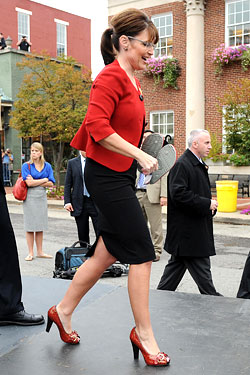
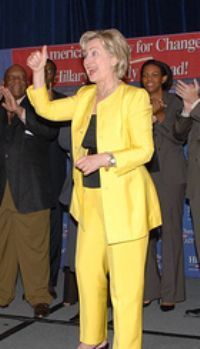
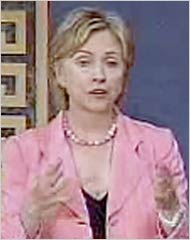
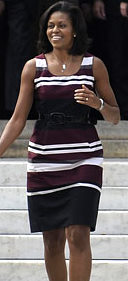


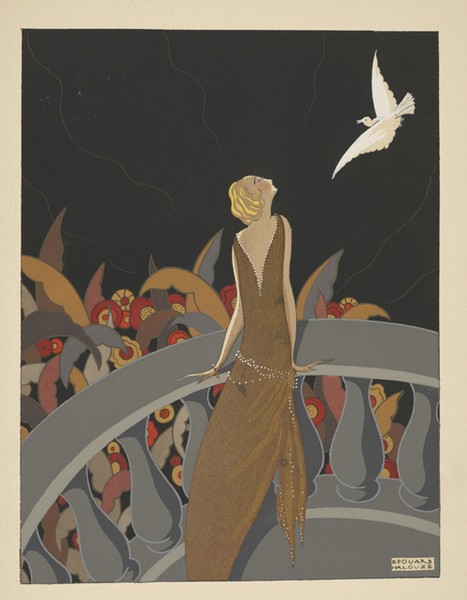
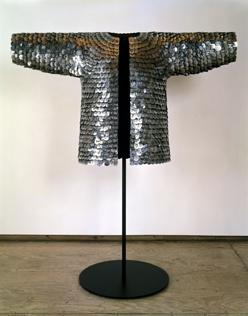
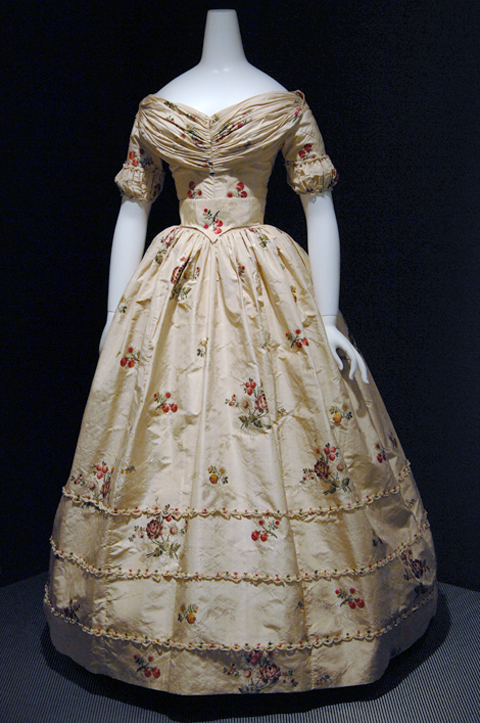

























1 comment
Karina says:
Apr 1, 2009
So I was thinking about your blog, and somewhere in there you said something about sexuality scaring people in politics, and I thought, “That can’t be true! Scaring?” and I’ve been falling asleep trying to think of examples… Here’s my take:
Sexuality doesn’t *scare* people, it makes them not trust things to be real. For example, are we voting for them because they are sexy, or because they are smart and capable? Morons (like John McCain) do not question their basest desires BUT they teach the rest of us a lesson on how lust can bring us down in the end, which is not a good thing when you’re working with a democracy. Raised on a diet from the Age of Reason seasoned with Protestant Revivalism, we know that sometimes what we desire most is bad for us. Sexy politicians simply do not exist. JFK Junior never would have made it, and neither would John Edwards. Bill Clinton may have been sexy in person but photos sure as hell didn’t show it. Strom Thurmond, Barney Frank, Diane Feinstein just prove my point…
Of course, then there are the French — Sarcozy and Bruni are the exception that prove the rule, and prove that the French must have wayyyyy better sex lives than the rest of us. Of course, they also have democracies that morph into dictatorships (e.g., Napoleon — case and point).
Anyway, the difference between “scare” and “trust” is simply one of emotion vs. reason. No biggy.
Looking forward to seeing more!